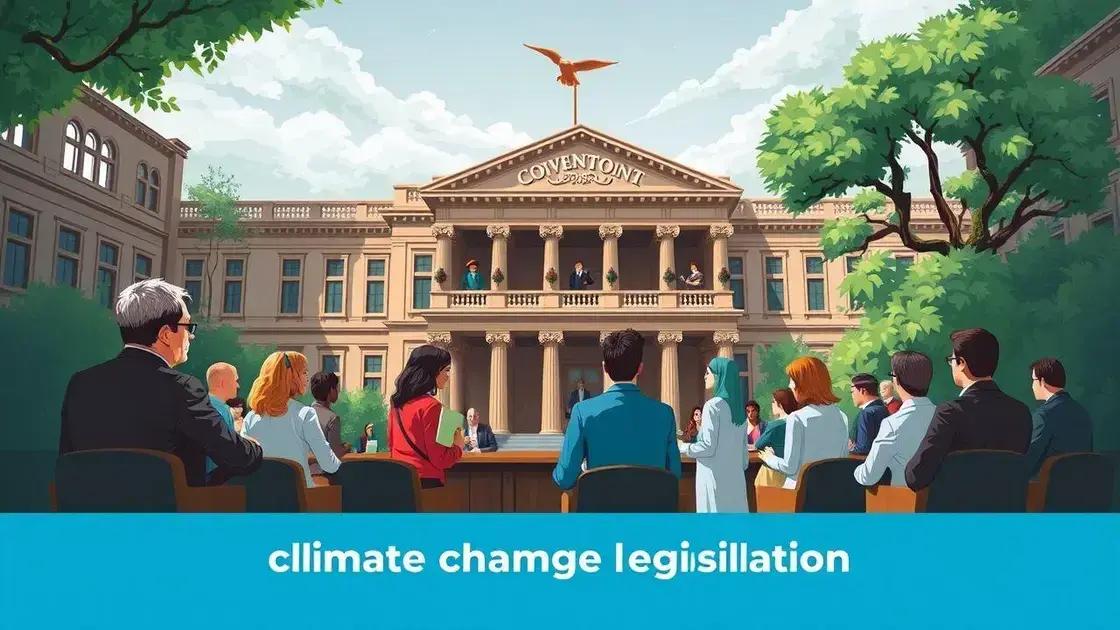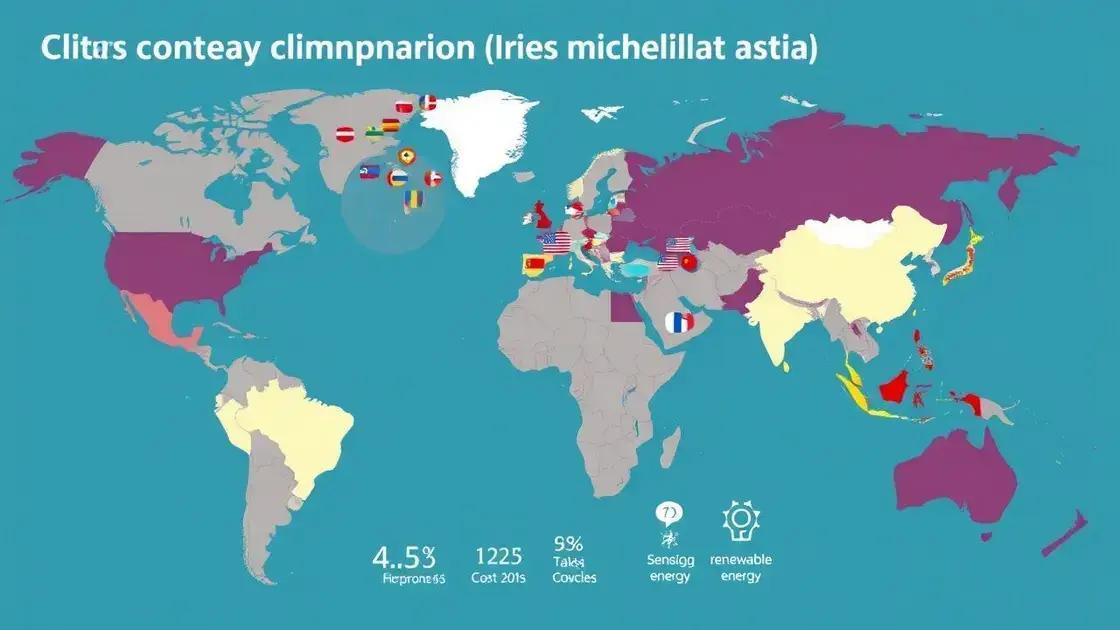Climate change legislation: what you need to know now

Climate change legislation encompasses laws and policies aimed at reducing greenhouse gas emissions, promoting renewable energy, and ensuring sustainable development while addressing economic and environmental challenges globally.
Climate change legislation is reshaping our world, sparking discussions about policies that aim to protect the planet. But how does it really affect your daily life? Let’s dive into its implications.
Understanding climate change legislation
Understanding climate change legislation is essential for everyone. It shapes how countries address environmental issues and impacts our lives directly. In this section, we will explore the key aspects of these laws and what they mean for people around the world.
What is climate change legislation?
Climate change legislation consists of laws and policies designed to reduce greenhouse gas emissions and prepare for the impacts of climate change. These laws aim to create a sustainable future by addressing the sources of pollution and promoting clean energy solutions.
Key elements of climate laws
Most laws include specific targets and deadlines. These aspects guide governments on how quickly to achieve climate goals. Important components often include:
- Emission reduction targets
- Regulations on industries
- Support for renewable energy sources
Countries also implement measures to adapt to climate impacts. This includes investing in infrastructure and improving community resilience. By understanding these key elements, we can see how legislation affects our daily lives.
Additionally, public participation plays a crucial role. Citizens can influence climate policies through advocacy and by voting for leaders who prioritize the environment. This involvement helps ensure that legislative decisions reflect the community’s needs and values.
Examples of successful legislation
Many countries have enacted effective climate change laws. For example, some regions have implemented carbon pricing systems. This approach encourages companies to lower emissions while generating revenue for sustainability projects.
- California’s Global Warming Solutions Act
- European Union’s Green Deal
- United Kingdom’s Climate Change Act
These laws not only aim to cut greenhouse emissions but also drive innovation in clean technologies. Understanding these examples showcases how legislation can pave the way for a greener future.
Key components of climate policies

To understand climate change laws, it’s essential to focus on the key components of climate policies. These components address various environmental challenges and aim to foster a sustainable future.
Emission Reduction Targets
One of the primary goals of climate policies is to set emission reduction targets. These targets specify how much greenhouse gases a country aims to cut over a certain period. Setting clear targets motivates governments to take action and track their progress over time.
Support for Renewable Energy
Another vital component is promoting renewable energy sources. This includes solar, wind, and hydroelectric power. By investing in renewables, countries can reduce their reliance on fossil fuels, which are a major source of emissions. Policies may offer incentives for businesses and homeowners to switch to cleaner energy options.
- Tax credits for solar panels
- Grants for wind energy projects
- Research funding for new technologies
In addition to promoting renewables, climate policies often incorporate regulations on industries. These regulations are designed to limit the amount of pollution companies can produce. For instance, specific rules may require factories to use cleaner technologies or implement better waste management practices.
Adaptation Strategies
Effective climate policies also include adaptation strategies. These strategies help communities prepare for the impacts of climate change, such as extreme weather events. Measures may involve enhancing infrastructure, protecting natural habitats, and creating emergency response plans. By focusing on adaptation, governments can safeguard both people and ecosystems.
The success of climate policies depends on public engagement and awareness. Empowering citizens to take action is crucial. When communities understand these components, they can participate in discussions and advocate for more effective policies. This active participation leads to a more informed and responsible society.
Impact on businesses and individuals
The impact on businesses and individuals from climate change legislation is significant and far-reaching. Understanding these effects helps to grasp why these laws are vital for our future.
Business Adaptation to Climate Policies
Businesses must adjust to new regulations aimed at reducing their environmental footprint. This can involve adopting more sustainable practices or investing in cleaner technologies. Companies that proactively embrace these changes can even gain a competitive edge.
- Reducing waste and increasing recycling
- Switching to renewable energy sources
- Implementing energy-efficient production processes
Firms that fail to adapt may face penalties or lose market relevance. Therefore, navigating climate change legislation is crucial for long-term success.
Effects on Individual Consumers
For individuals, the effects of climate policies can be felt in various ways. While these laws aim to improve environmental health, they may also lead to changes in lifestyle and spending. For instance, consumers may see increased costs for energy or goods produced using environmentally harmful practices.
On the positive side, individuals might benefit from incentives for energy efficiency in their homes or access to cleaner energy. This could include:
- Tax credits for solar panel installations
- Subsidies for energy-efficient appliances
- Lower utility bills from renewable energy adoption
As a result, individuals can end up saving money in the long run while doing their part for the planet.
Moreover, climate change legislation often encourages public engagement. Individuals can partake in advocacy efforts or local projects aimed at promoting sustainability. As communities work together, they help launch initiatives that benefit both the economy and the environment. The connection between climate laws, business actions, and individual responsibility is crucial in creating a more sustainable world.
Global examples of effective legislation

There are many global examples of effective climate change legislation. These laws demonstrate how countries can take charge in addressing environmental challenges. By examining these examples, we can learn from successful strategies.
California’s Global Warming Solutions Act
California has been a leader in climate action with its Global Warming Solutions Act. This landmark legislation set specific goals to reduce greenhouse gas emissions to 1990 levels by 2020. It established programs to promote renewable energy and improve energy efficiency.
The European Union’s Green Deal
The European Union (EU) is working towards a sustainable future with its Green Deal. This comprehensive plan aims to make Europe the first climate-neutral continent by 2050. It covers various sectors, from energy to transportation, and includes laws that support the shift to clean energy.
- Investment in clean technologies
- Reduction of carbon emissions
- Support for sustainable agriculture
This approach is designed to not only tackle climate change but also create new jobs and boost economic growth.
United Kingdom’s Climate Change Act
The UK was the first country to introduce a national Climate Change Act in 2008. This act requires the government to set legally binding carbon budgets, which help ensure substantial cuts in emissions over time. It has been pivotal in driving the UK’s transition to a low-carbon economy.
The success of these global examples highlights the importance of strong legislative frameworks. They showcase that effective climate policies can lead to significant reductions in emissions, promote green technologies, and stimulate economic growth. Countries can learn from each other’s experiences to implement impactful laws tailored to their unique contexts.
Challenges in implementing climate laws
Implementing climate laws comes with several challenges that can hinder progress. Understanding these obstacles is crucial for developing effective solutions and achieving environmental goals.
Lack of Political Will
One major challenge is the lack of political will to fully commit to climate action. Sometimes, lawmakers prioritize short-term economic gains over long-term sustainability. This can result in insufficient funding for climate initiatives or reluctance to enforce strict regulations.
Economic Concerns
Economic concerns also play a significant role. Industries often fear that stringent climate laws will increase operational costs, leading to job losses. Balancing economic stability while aiming for sustainable development can be a complex task for governments.
- Resistance from business sectors
- Concerns over competitiveness
- Fear of job losses in traditional industries
Finding ways to support a just transition for workers in affected industries is vital, ensuring they have opportunities in green jobs.
Public Awareness and Engagement
Another challenge is the level of public awareness regarding climate issues. Many people may not understand the significance of climate laws or their implications for daily life. Increasing public engagement is critical to garner support for these laws and to encourage sustainable practices.
Moreover, misinformation can spread easily, leading to confusion and skepticism about climate change. Effective communication strategies are essential to inform the public accurately and promote a collective effort in tackling climate challenges.
International Cooperation
Finally, international cooperation poses its own set of challenges. Climate change is a global issue that requires collaborative efforts. Disagreements among countries about responsibilities and emissions reduction targets can hinder progress. Establishing effective partnerships and frameworks is necessary for achieving meaningful change.
Overcoming these challenges will require committed leadership, innovative solutions, and a collective effort from all sectors of society. With the right approach, it is possible to create a sustainable future.
Future trends in climate change regulation

Future trends in climate change regulation are shaping how countries approach environmental issues. As the effects of climate change become more apparent, governments are adopting innovative strategies to reduce greenhouse gas emissions.
Increased International Collaboration
One significant trend is increased international collaboration. Countries are joining forces to share resources and knowledge in tackling climate change. By participating in global agreements, nations can set common goals and track progress collectively.
Carbon Pricing Mechanisms
Another growing trend is the implementation of carbon pricing mechanisms. These systems assign a cost to carbon emissions, encouraging industries to innovate and adopt cleaner technologies. By making polluters pay, carbon pricing can drive significant reductions in emissions.
- Carbon taxes
- Cap-and-trade systems
- Emissions trading schemes
These financial incentives not only help the environment but can also provide governments with revenue to fund sustainable initiatives.
Focus on Sustainable Development
Moreover, there is a heightened focus on sustainable development. Countries are beginning to incorporate environmental considerations into their economic plans. New policies are emerging that allow for growth while protecting natural resources and addressing social equity.
For example, green infrastructure projects aim to enhance urban environments while reducing carbon footprints. This approach not only sustains local economies but also promotes healthier communities.
Innovation in Clean Technologies
Technological innovation is also a critical component of future climate legislation. Rapid advancements in renewable energy, energy efficiency, and carbon capture are transforming how energy is produced and consumed. As these technologies become more affordable and widespread, they will play a pivotal role in meeting climate goals.
As we look to the future, it is essential to remain adaptable. Policymakers must be open to change and willing to prioritize sustainable practices. By doing so, the world can work towards mitigating climate change and ensuring a healthier planet for generations to come.
FAQ – Frequently Asked Questions about Climate Change Legislation
What is climate change legislation?
Climate change legislation refers to laws and policies designed to reduce greenhouse gas emissions and promote environmental protection.
How does carbon pricing work?
Carbon pricing assigns a cost to carbon emissions, incentivizing businesses to reduce their carbon footprint and invest in cleaner technologies.
Why is public awareness important for climate action?
Public awareness helps garner support for climate initiatives, leading to stronger community engagement and effective policy implementation.
What are some examples of successful climate laws?
Examples include California’s Global Warming Solutions Act and the European Union’s Green Deal, both aimed at reducing emissions and promoting sustainable practices.






